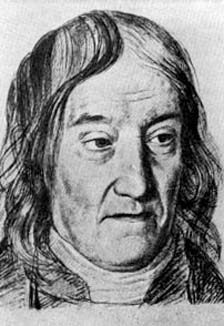Farkas Bolyai facts for kids
Quick facts for kids
Farkas Bolyai
|
|
|---|---|

Farkas Bolyai
|
|
| Born | 9 February 1775 Bolya, Grand Principality of Transylvania (now Buia as part of Șeica Mare, Romania)
|
| Died | 20 November 1856 (aged 81) Neumarkt am Mieresch, Grand Principality of Transylvania, Austrian Empire (now Târgu Mureş, Romania)
|
| Nationality | Hungarian |
| Alma mater | University of Jena University of Göttingen |
| Known for | Contributions to the foundations of geometry Wallace–Bolyai–Gerwien theorem |
| Scientific career | |
| Fields | Mathematics |
| Academic advisors | Abraham Gotthelf Kästner |
| Notable students | János Bolyai |
Farkas Bolyai (born February 9, 1775 – died November 20, 1856) was a Hungarian mathematician. He is mainly known for his important work in the field of geometry. He also made contributions to other areas of mathematics.
Contents
Early Life and Education
Farkas Bolyai was born in a village called Bolya. This village was near Hermannstadt in Transylvania. Today, this area is part of Romania. His parents were Gáspár Bolyai and Krisztina Vajna.
Farkas was taught at home by his father until he was six years old. Then, he went to a Calvinist school in Nagyszeben. His teachers quickly saw how talented he was. He was especially good at math and learning new languages.
He learned many languages easily. These included Latin, Greek, Romanian, and Hebrew. Later, he also learned French, Italian, and English. He could do amazing math in his head. He could multiply and divide very large numbers. He could also find square and cube roots without a calculator!
When he was 12, he left school. He became a tutor for an eight-year-old boy named Simon Kemény. Simon was the son of a count, a very important person. Farkas became a close friend to Simon, not just his teacher.
In 1790, Farkas and Simon both went to the Calvinist College in Kolozsvár. They studied there for five years.
Studying Mathematics in Germany
A philosophy professor at the college tried to make Farkas focus on religious philosophy instead of math. However, Farkas decided to travel abroad in 1796 with Simon Kemény. He began to study mathematics seriously at German universities.
First, he studied at the University of Jena. Then, he went to the University of Göttingen. During this time, Bolyai became a close friend of the famous mathematician Carl Friedrich Gauss.
Family and Teaching Career
Farkas Bolyai returned home to Kolozsvár in 1799. There, he met and married Zsuzsanna Benkő. Their son, János Bolyai, was born in 1802. János later became an even more famous mathematician than his father.
Soon after, Farkas accepted a teaching job. He taught mathematics and science at the Calvinist College in Marosvásárhely. Today, this city is called Târgu-Mureş. He spent the rest of his life teaching there.
Mathematical Discoveries and Ideas
Farkas Bolyai was very interested in the basic ideas of geometry. He also spent a lot of time thinking about the parallel axiom. This is a rule in geometry about parallel lines.
His Main Book: Tentamen
His most important work was a book called Tentamen. The full title means "An Attempt to Introduce Studious Youths to the Elements of Pure Mathematics." He published it in 1832. In this book, he tried to create a very clear and organized way to understand geometry, arithmetic, algebra, and analysis.
In his book, he showed ways to solve equations step-by-step. He also studied how number series behave. He even discovered a test for series convergence. This test helps mathematicians know if a series of numbers will add up to a specific value. He found this test on his own, around the same time as another mathematician named Raabe.
Another important idea in his book was about comparing flat shapes. He said two flat shapes are equal if you can cut them into the same number of matching pieces.
Encouraging His Son's Work
At first, Farkas tried to tell his son, János, not to study non-Euclidean geometry. This was a new and different kind of geometry. But by 1832, Farkas became very excited about his son's ideas. He convinced János to publish his amazing new thoughts. János's ideas were then published as an extra part of Farkas's Tentamen book.
See also
 In Spanish: Farkas Bolyai para niños
In Spanish: Farkas Bolyai para niños

